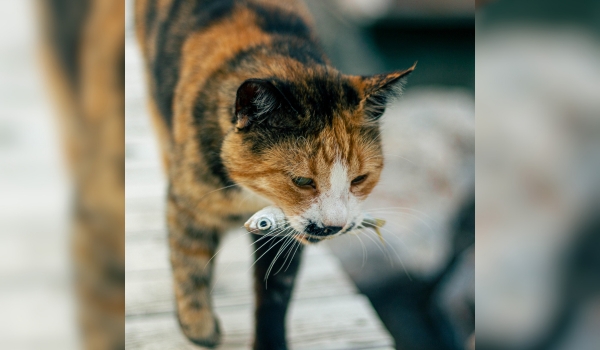Your dear, most beloved cat is going through a tapeworm infestation, and you do not know how to care for it. Our sympathies are with you. It can be hard for pet parents to see their bundles of joy in pain. When you are confused about balancing care for and limiting the infection, things get more complicated.
So many find themselves asking, should I quarantine my cat with tapeworms? You love them with all your heart, so it is hard to limit them.
But also, you do not want them dropping potentially infectious material everywhere and making other pets and children in the house vulnerable.
Fret not, dear reader. Let us unpack the infection, care, quarantine, and prevention below.
Should I Quarantine My Cat with Tapeworms?
Yes! You should always quarantine your cat with tapeworms to prevent the infection from spreading to other pets in the house or children.
Cats get infected by ingesting fleas or uncooked meat containing the parasite larva. Once inside and mature, the tapeworm starts reproducing and shedding the eggs that the kitty passes into her stool. Other pets in the house could get infected if they come in contact with infected cat feces or ingest a flea from the cat’s fur.
Therefore, you must keep your cat with fleas in a separate room and provide her with separate eating and drinking dishes, a litter box, toys, etc. Besides that, you should always thoroughly wash your hands after handling your cat with parasites.
If you do not isolate your cat with fleas, it would be spreading fleas and tapeworm eggs all around, making it a hotbed for spreading the infection to other pets, especially cats, as they groom each other. It also means the cat could pick up the infection right after recovery if the infectious flea it dropped earlier catches back up.
Why Should I Quarantine My Cat With Tapeworms?
Okay, we briefly explained that you should quarantine your cat with tapeworms. But naturally, the first question that pops up is, why?
One may even wonder about the point of putting the poor kitty away. It is for the good of the pet, your family, and the surroundings.
Let us show you how.
Quarantine the Cat with Tapeworms to Contain Infection
It is like treating any contagious infection. The cat may still be shedding tapeworm eggs from its stool, and you do not want it to spread any further.
Think of it as keeping a child suffering from the flu at home. The treatment will take its time; the condition will run its course. But keeping them inside the home prevents its spread to others.
Similarly, keeping the cat in quarantine breaks the chain.
Quarantine the Cat with Tapeworms for Hygiene Purposes
One of the first things to do as soon as you find out about a tapeworm infection is to disinfect the house. Unwittingly, the cat could easily have dropped fleas or proglottids around the house. Now, besides an infected cat, you also have an entire house to clear of fleas and tapeworm eggs.
Putting the cat under quarantine ensures the rest of the house can remain free of infectious material. Nobody wants their house swimming in tapeworm soup.
Or chance upon a lousy flea as they relax on their sofa. Urgh!
Now you just need to pay special attention to the sick room alone.
Quarantine the Cat with Tapeworms to Protect Your Family
Ok, even if the chances of a cat passing off the tapeworms to humans are slim, they are there. The prime culprit here would be fleas, the intermediate host of these pests.
If you let the infected cat have free reign, the infectious material would be all over the place.
That means an increased risk of humans in the household catching the infestation if they were to ingest the fleas of eggs. It is not very hard to imagine what happens next.
Deconstructing Infection of a Cat with Tapeworms
You can only prevent or cure what you understand. Educating yourself about the pest is the first line of defense.
Prevention, care, and infection control guidelines make sense when you get to know the reasons behind each. Read along to find out about the pesky tapeworm, how it finds its way to pets, and what signs to look for.
What are Tapeworms?
Named so, thanks to their flattened, strip-like appearances, these are intestinal parasites. Living off the nutrients of their definitive host, tapeworms do not cause any serious harm to cats.
Adult tapeworms hook themselves to the host’s intestinal wall, with their heads called Scolex. A structure aided by suckers, grooves, and hooks to attach. Next comes the neck, from where new segments emerge. And last, the strobila, the segmented region.
It keeps growing newer segments, pushing the older segments along, and elongating the worm in the process.
These segments are the real culprits as they carry both the male and female organs, producing eggs that fill these segments.
Eventually, depending on the species, the segment filled with eggs or just the eggs are released. That is when you notice tapeworms in your pet’s feces.
Types of Tapeworms Infecting Cats
Dipylidium, popularly known as the flea tapeworm/cucumber tapeworm, is the most common tapeworm infection. But dear reader, the enemy wears many masks and sneaks in through several routes.
That is to say, there are several types of tapeworms, each with a set of species. But the variety infecting the pets depends on their particular environment and exposure.
Go over our table, briefing key information about the types of tapeworms that could infect your cat.
| Type | Intermediate Host | Size | Pre-patent Period | Symptoms | Diagnosis |
| Dipylidium caninum | Fleas, louse | Up to 50 cm | 3 weeks | Subclinical May include diarrhea, itching at the anus, & abdominal pain | Proglottids in stool Examination under microscope |
| Diphyllobothrium latum | Crustaceans, fish | Up to 20 m | 3 weeks | Subclinical May include diarrhea, vomiting, & weight loss | Empty proglottids pockets in stool Fecal examination |
| Mesocestoides | Arthropods, Amphibians, Birds, Reptiles, Mammals | Up to 70 cm | 2 weeks (at least) | Subclinical | Moving proglottids in the feces & around the anus Examination under microscope |
| Taenia | Rodents, rabbits/ hares, horses | Approx. 60 cm | 4 – 11 weeks | Subclinical May include vomiting, diarrhea, | Proglottids in feces Fecal examination |
| Echinococcus | Horse, Deer, pig, ruminant (cow) | About 0.5 cm | 40 days | Subclinical | Eggs in feces (difficult to notice) PCR Test |
| Spirometra | Small crustaceans, snakes, frogs, birds, mammals | 1.5 m | 3 weeks | Vomiting, diarrhea | Fecal examination |
* Pre-patent period is the time required after ingestion for a tapeworm larva to mature and start reproduction inside the final host
What Are The Signs Your Cat Has Tapeworms?
Trying to identify if your cat has tapeworms can be slightly tricky. You see, like some other infestations, this is not particularly nasty. So, your cat could look just fine and still have it.
But watching your pet closely can do wonders. In fact, tapeworms are most commonly discovered by owners in the stool of their pets.
Symptoms of tapeworm infection include;
- Egg packets, called proglottids, are in the feces or litter box of the cat.
- Proglottids around the kitty’s anus or lower tail.
- Cat scratching or dragging (rare) its bottom to relieve irritation by dried proglottids around its anus.
- No noticeable health issues, but in some cases, vomiting, diarrhea, or even weight loss may be observed.
- Occasionally, the tapeworm may move to the stomach and could be noticed in the vomit.
- Even though less likely, the cat could serve as the secondary and not the definitive host of the variety Mesocestoides. In this case, it may develop peritonitis, inflammation of the peritoneal cavity.
How Does A Cat Get Infected With Tapeworms?
Cats get infected with tapeworms when they ingest their larval form. And that happens when the deceptive intermediate host presents the opportunity.
You see, tapeworms can need, depending on the variety, one or more intermediate hosts. The eggs are released in the feces of the infected individual. An intermediate host receives the egg from the environment.
Again, depending on the type of pest, fleas, small crustaceans, or termites could consume the tapeworm egg.
Once inside, the egg hatches and relies on the host’s nutrients to grow into a larva. In the case of an aquatic intermediate host, the small crustacean can be consumed by a fish. When eaten raw or undercooked, fish can introduce the tapeworm to the cat.
Similarly, species of tapeworm could exchange between one or more intermediate terrestrial hosts to grow into larvae.
If the cat has fleas/louse, it may accidentally ingest them while grooming. Eating uncooked infected fish or meat can also introduce the larva into the cat’s body. Hunting an infected animal or a flea-infested rodent would do the same.
From there, the tapeworm larva finds its way to the small intestine and lodges itself by hooking to its walls.
Living off the cat’s nutrients, the larva matures into an adult tapeworm, growing new segments and producing eggs within these segments. Once a segment is full, depending on the variety, it may either directly release the eggs or the packets into the feces.
Mostly the infected cat shows no clinical signs but can sometimes show gastrointestinal troubles, such as vomiting or diarrhea.
What to Do When a Cat Gets Infected with Tapeworms?
Ok, so you know a great deal about cat tapeworm infestation now. The next big question staring into your face would be how to care for and prevent future infections. Let’s dig in.
- Start the Deworming Course
This one is obvious. The cat is already infected; the first thing you want to do is to start the deworming process.
Now there are several dewormers for cats available, and several are broad-spectrum. But it would be foolish to play the doctor yourself. Your best hope is to get a proper diagnosis from a registered vet and get the prescription.
Once you have the doctor’s advice, start the deworming right away.
Typically, the medicine would either be given orally or via an injection. It can take anywhere between a few days to a couple of weeks until the medicine completes the job. In so doing, the tapeworms would be digested and would no more appear in the feces.
- Isolate the Cat
This is what you came looking for. Should I quarantine the cat with tapeworms? In a clean, airy, nicely lit room, we bet you should.
Provide all the necessary amenities a cat needs. Ensure there is sufficient food and water. The bowls would still need to be refilled at regular intervals. And do not forget the toys.
Think of the same sick child analogy. You need them to stay put until they recover, but you also need to keep them happy.
We cannot stress it enough, but by isolating the cat, you would do a service to your family, including the cat. And the other families around you. This is especially important if you have other pets or small children.
Small kids can catch tapeworms from the cat by accidentally ingesting the fleas.
Some of the tapeworm larvae could remain infective in the environment for a year or two. Not letting your infected cat out prevents them from defecating outdoors.
Eventually, preventing the spread of infectious material.
- Clean Everything
Really, as soon as you suspect the cat may have a tapeworm infestation, isolation and cleaning should be the first two things you do.
Clean everything, including the obvious spots such as their personal use items. Thoroughly wash and disinfect their bedding, blanket, toys, food, and water bowls.
Properly clean, wipe and disinfect their litter box.
The disinfection program goes way beyond that. Every surface the cat frequents or even is likely to access will need cleaning.
Be it your couch, the rug, or even the floor. You do not want any germs to be lying around. It poses a risk of reinfection or infecting other pet members of the family.
If you cannot wash a surface, wipe it clean with a disinfectant. Ensure the safety of everyone.
- Treat Against Fleas
Deworming and flea control programs go hand in hand. These are the most common culprits inviting the pest to your cat’s gut.
A great preventive care technique would be to ensure flea prevention is in place. Give regular baths and grooming. Use anti-flea shampoos to be on the safe side.
- Give it Cooked Meat
Many varieties of tapeworms find their way into your kitty’s intestine because it eats raw or undercooked meat. Sure, there are advocates for serving raw meat to cats. But look at the risks it poses.
Also, it is not something a vet would suggest. Serving your pet raw meat exposes them to a host of pathogens and pests.
Fret not if you like to offer the cat some yummy meat treats. It is fine as long as it is properly cooked, devoid of any seasonings, in small quantities, and infrequent. Check out our comprehensive guide on what human foods cats can eat or not eat.
- Keep Your Cat Indoors
You can cook the meat all you want, but you cannot do anything about the little adventure your cat goes on. They itch to pounce on a mouse or a bird.
It is all fun and games until the mice or other carcass ends up infecting them. They may even get infected by eating the meat or feces of the infected intermediate host.
Keeping it indoors effectively minimizes the risk of tapeworm infestation and other illnesses.
Cats still need to play and exercise to remain healthy. So, implementing cat-safe pest control in your lawn or backyard could be super helpful. In a pest-free yard, you can let your kitty roam freely and jump around without fearing tapeworm infestation.
- Ensure Hygiene
If COVID has taught us anything, it is important to keep our hands clean. Wash your hands after petting the cat.
It also means thoroughly and vigorously washing the product or any berries you may have collected.
The deadliest tapeworms for humans find their way inside their bodies via water or food that comes into contact with the feces of the infected final host.
And while you are at it, remember to teach kids about hygiene when introducing pets to them. Sure, have fun, and try to create a loving bond between your kids and your tiny friends. But also teach them about washing their hands afterward.
Also, if a visiting pet turns out to be infected, implement cleaning and flea control to avoid any infection.
- Regular Deworming
Getting infected with tapeworms does not produce any immunity against future re-infections. The process is necessary during kittenhood and needs to be continued into adulthood.
Consult your vet to discuss how often the cat needs to take the course. The history of a cat’s infection can tell us about its hunting fetish.
Controlling that, setting up pest control, and regular deworming when the need arises could be highly useful.
Remember, the pre-patent period of each variety of tapeworm varies. They will need a follow-up course once the cycle completes to avoid reinfections.
Final Words: Should I Quarantine My Cat With Tapeworms?
Yes, cats infected with tapeworms should be isolated to prevent the spread of infection. Immediately start deworming and clean every surface, including the cat’s personal use items. Start the flea control program all the same and run another course of deworming after the pre-patent period as a precaution.







